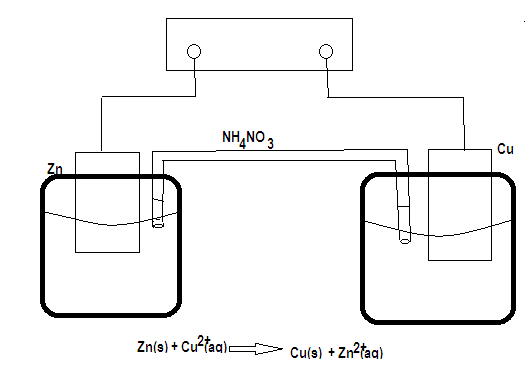
In an galvanic cell, the salt bridge:
A. does not participate chemically in the cell reaction
B. stops the diffusion of ions from one electrode to another
C. is necessary for the occurrence of the cell reaction
D. ensures mixing of the two electrolytic solution
Answer
485.4k+ views
Hint: A most remarkable feature of oxidation-reduction reactions is that they can be carried out with the reactants separated in a space and linked only by an electrical connection that is to say, chemical energy is converted to electrical energy .
Step by step answer: Consider figure representation of galvanic cells which involve reaction between metallic zinc and cupric ion. One can see that the cell consists of two beakers, one of which contains the solution of

Flow of the solution from the salt bridge is prevented either by plugging the ends of the bridge by glass wool, or by using a salt dissolved in a gelatinous material as a bridge electrolyte. The purpose of the salt bridge is to prevent any net charge accumulation in either beaker, diffuse through the bridge and enter the left beaker at the same time there can be diffusion of positive ions from left to right if this diffusional change of ions do not occur, the net charge accumulating in the beaker would immediately stop the electron flow through the external surface and the oxidation reduction reaction would stop. Thus while the salt bridge does not participate chemically in the cell reaction, it is necessary for the cell to operate.
Hence from above we can conclude that the correct option is A.
Note: The galvanic cell mentioned above is represented in a short IUPAC cell notation as follows:
Zn/
Step by step answer: Consider figure representation of galvanic cells which involve reaction between metallic zinc and cupric ion. One can see that the cell consists of two beakers, one of which contains the solution of

Flow of the solution from the salt bridge is prevented either by plugging the ends of the bridge by glass wool, or by using a salt dissolved in a gelatinous material as a bridge electrolyte. The purpose of the salt bridge is to prevent any net charge accumulation in either beaker, diffuse through the bridge and enter the left beaker at the same time there can be diffusion of positive ions from left to right if this diffusional change of ions do not occur, the net charge accumulating in the beaker would immediately stop the electron flow through the external surface and the oxidation reduction reaction would stop. Thus while the salt bridge does not participate chemically in the cell reaction, it is necessary for the cell to operate.
Hence from above we can conclude that the correct option is A.
Note: The galvanic cell mentioned above is represented in a short IUPAC cell notation as follows:
Zn/
Recently Updated Pages
Master Class 12 Business Studies: Engaging Questions & Answers for Success

Master Class 12 English: Engaging Questions & Answers for Success

Master Class 12 Social Science: Engaging Questions & Answers for Success

Master Class 12 Chemistry: Engaging Questions & Answers for Success

Class 12 Question and Answer - Your Ultimate Solutions Guide

Master Class 12 Economics: Engaging Questions & Answers for Success

Trending doubts
Give 10 examples of unisexual and bisexual flowers

Draw a labelled sketch of the human eye class 12 physics CBSE

Differentiate between homogeneous and heterogeneous class 12 chemistry CBSE

Write a short note on Franklands reaction class 12 chemistry CBSE

Differentiate between insitu conservation and exsitu class 12 biology CBSE

What are the major means of transport Explain each class 12 social science CBSE




